
Guests
- Barbara PopovicExecutive Director of Chicago Access Corporation–CAN TV–in Chicago.
- Annie FolgerExecutive Director of Midpeninsula Community Media Center in Palo Alto, California.
- Sue BuskePresident of the Buske Group, a Sacramento-based telecommunications consulting firm. Former head of the National Federation of Local Cable Programmers, now known as the Alliance for Community Media.
Community media groups are accusing the telecom giant AT&T of discriminating against local public access channels across the nation, and the deadline for public comment is midnight tonight. The dispute centers around how AT&T delivers public television stations to customers. Instead of putting the stations on individual channels, AT&T has bundled community stations onto a generic channel that can only be navigated through a complex and lengthy process. Public television advocates say AT&T is imposing unfair restrictions that will severely restrict audiences. [includes rush transcript]
Transcript
AMY GOODMAN:
Community media groups are accusing the telecom giant AT&T of discriminating against local public access channels across the country, and the deadline for public comment is midnight tonight. The dispute centers around how AT&T delivers public television stations to customers. Instead of putting the stations on individual channels, AT&T has bundled community stations into a generic channel that can only be navigated through a complex and lengthy process. Public television advocates say AT&T is imposing unfair restrictions that will severely restrict audiences.
The groups have filed a regulatory challenge against AT&T with the Federal Communications Commission. And a House Appropriations subcommittee has also asked the FCC to look into the allegations. A public comment period ends at midnight tonight. That’s Eastern Standard Time.
I’m joined now by three guests who have been active in seeking fair access for community media. Joining me from Chicago is a public access icon. She’s Barbara Popovic. She’s executive director of Chicago Access Corporation, known as CAN TV. Joining me on the telephone from Palo Alto, California, is Annie Folger. She’s executive director of the Midpeninsula Community Media Center, serving the Bay Area. And on the line from Sacramento, California, is Sue Buske. She’s president of the Buske Group, which is a Sacramento-based telecommunications consulting firm. Sue is also the former head of the National Federation of Local Cable Programmers, now known as the Alliance for Community Media.
We did ask representatives of AT&T to appear on the broadcast, but they didn’t respond to our request.
Barbara Popovic, let’s begin with you. I think the way legislation often gets passed is that it’s so complicated, no one really understands it. Can you talk about what it is you’re so concerned about right now?
BARBARA POPOVIC:
Well, you know, when I got ready come in to do the show this morning, I looked on your website for Democracy Now! and saw the stations that this program plays in Illinois, for example. I wanted to let a few people know. And it was very simple: channel 19, channel 6. I mean, this is what people have come to expect. Someone who is a U-verse customer now, picks up a program guide like this, they see 350-odd channels and not a single public channel is listed.
AMY GOODMAN:
Explain what you mean —
BARBARA POPOVIC:
That’s one of many of the deficits of this system.
AMY GOODMAN:
Barbara, can you explain what you mean by “U-verse”?
BARBARA POPOVIC:
Well, AT&T has started a new system it calls U-verse, and this has all kinds of bells and whistles, so that when people go to watch a program, AT&T, on its own website, advertises things like fast channel change, easy-access-to-a-program guide. Sadly, though, none of those benefits are available for these public channels. People have come to expect to be able to do a simple thing like channel surf between a broadcast channel, a public channel, whatever they wish to see, to do a DVR recording when they go off to work during the day. Thirty percent of the population now rely on DVR recordings in order to be able to watch the program they want to see.
None of these benefits are available on U-verse, on AT&T’s new product for television viewers, for public access channels, and this is a grave concern for educators, government entities, for the emergency alerts that those cities put out, for local residents who want to communicate, for Democracy Now!, for that matter, to reach the people you’re reaching every day. So this is really a very inferior system, and for the first time in the history of PEG access, it’s a clearly discriminatory decision to put these channels in an inferior format in every way that matters to a viewer.
AMY GOODMAN:
A consumer rights board, the California Public Utilities Commission, Division of Ratepayer Advocates, put together a video on how difficult it is to access a community television station under the AT&T system. Normally, a TV viewer can switch from channel to channel, as you said, Barbara, but as this video shows, switching to a public station with AT&T takes over a minute, if you can figure it out.
MIKE GRIER: AT&T has chosen to group all community channels on channel 99. So the first thing that you would have to do is select channel 99. As you can see, in the lower screen, we’re waiting for further instructions. It says “OK.” Now it’s loading the public access platform. As you can see, it’s a computer-based application.
OK, once we get to the channel 99 menu, if you notice, all the communities are listed in alphabetical order. We want to watch City of San Francisco Board of Education meeting. So we reach San Francisco local government channels. Then another menu shows four channels available. OK. You can wait for the preview screen to show. Here we go.
So, as you can see, it took a minute and five seconds to go from a commercial channel to San Francisco Board of Supervisors meeting. Normally, it would have taken a second or two to select the specific channel that your cable provider has assigned for that particular government channel.
AMY GOODMAN:
That was Mike Grier, a community activist. Now, Barbara Popovic, that took a very long time. That’s what you have to go through every time you want to turn the channel?
BARBARA POPOVIC:
You do, and the length will vary, and AT&T will argue that it’s going to be shorter than that. But the problem is the complexity, like you mentioned, Amy. People are going to have to have a little manual, I think, to find these programs. And when you think that these are educators — we’ve got eight HIV/AIDS agencies, four domestic violence agencies. These are people that need immediate access to their audience, not to be shunted aside, moved off out of reach. Like one of our educators said, “out of sight, out of mind” for this programming.
AMY GOODMAN:
Annie Folger, you testified before Congress. You’re the executive director of the Midpeninsula Community Media Center in Palo Alto. Explain your concerns in California.
ANNIE FOLGER:
Well, one of the biggest concerns that we have focuses around the issue of closed captioning of educational programming. The FCC rules require that video program distributors pass through closed-captioned educational material as closed captioned. AT&T passes through closed captioning on all of their commercial channels, but it does not and cannot pass through closed captioning on PEG channels. It can only offer the captioning as open, which means that it’s always on the screen, which means that it’s blocking a portion of the educational information that students are trying to benefit from. So, this open captioning interferes with viewers who are not hearing impaired and even viewers who are hearing impaired who cannot occasionally flip off the captioning to see the whole picture, to get the whole PowerPoint presentation, for example, that the lecturer may be presenting.
In addition, as Barbara mentioned, there’s no ability to record a program on one of the PEG channels and watch later. How many students are home at exactly the time when the course that they’re taking is being offered? So what we’re saying is educational programming deserves equal and fair treatment. It should not be treated as second-class citizen.
AMY GOODMAN:
Last September — and I believe, Annie Folger, this is the hearing you testified before — the House Appropriation Committee’s Subcommittee on Financial Services and General Government held a hearing on AT&T’s practices. I wanted to play a clip of Republican Congress member Mark Kirk of Illinois. This is some of what he had to say.
REP. MARK KIRK: On this hearing, also, if there was any thought by AT&T that the Republican member here at the hearing would help them out, let me disabuse them now. I think, with the local reporter, after talking to some of my communities, my view on AT&T was “And the horse you rode in on,” because I think their proposal falls way short of the mark.
I think this committee should take some action on this. It does appear that AT&T is in direct violation of Illinois law. And so, whether it is in Springfield or in Washington, we should fix this to make sure that there is a very convenient place, especially for our seniors, to find what’s happening in their local community and especially — this is something so important, that I breeze through local access cable like everyone else does, except when we’re doing a zoning or other issue related to my neighborhood, and then we are locked on this like everyone else. And to make sure that people can rapidly participate in their local democracy is what this is all about.
AMY GOODMAN:
Barbara Popovic of Chicago Access Corporation, CAN TV, so you have across-the-political-spectrum support here for public access. This is one of the Congress members in your district, a Republican Congress member, Kirk.
BARBARA POPOVIC:
Right. Representative Kirk has about, I don’t know, eight or nine cities in his district who do some excellent work on their PEG channels. They do emergency alerts. They’re very concerned that if there’s a “boil water” order, for example, in a suburb that’s right in the congressman’s district, that that “boil water” order will be seen by other communities that don’t need that emergency message. He recently had a lot of flooding there. We’ve had some trouble. In fact, over this weekend, we’ve had trouble with flooding. These public channels carry that message. On a cable system, the emergency message is conveyed in a very simple manner through the cable company. That is not the case with this PEG product, because, in fact, the channels are removed to an application where they put Yellow Pages and games. So, suddenly, the public programming is of little to no value in relation to the way AT&T is treating them on the system.
AMY GOODMAN:
I want to bring Sue Buske into this conversation, president of the Buske Group, former head of the National Federation of Local Cable Programmers. Is this an overall attack that we’re seeing on public access across the country, the place in the dial around cities and communities where people can make their own media in their own communities?
SUE BUSKE:
Yes, it very definitely is. And it’s something that we suspect has been planned by AT&T almost from the very beginning, when state legislation began to move forward about five years ago in Texas. And this is when AT&T was trying to change the law so that franchising for cable systems was no longer done at the local level, but at the state level. And the beta state is in the development of their U-verse product. I think they basically felt, “Nah, local governments, communities really don’t care that much about local programming and, specifically, PEG access.” And so, they came up with a way of trying to save themselves bandwidth and still sort of, more or less, fulfilling what they perceive to be the obligation to carry PEG channels under law. So, this is not a — this has been a longstanding evolution.
AT&T has promised to fix the problem, but the promises never were to do it the way regular cable systems do it with regard to delivering the access channels just like any other channel. And we’ve seen very, very little serious repair of this system that they are using to deliver PEG channels. So this is something that — they made a business decision. This isn’t a technical issue. This was a business decision they made to not treat access channels in the same way as they treat commercial channels.
AMY GOODMAN:
Barbara Popovic, now, the cable companies like, well, in New York, Time Warner, for example, they do have to support public access. If the telephone companies that are entering the cable market, like AT&T, start relegating it to this second-tier system, does that mean that the cable companies will then say it’s unfair competition, they also want to get rid of public access?
BARBARA POPOVIC:
One of the things we’ve already seen, and the FCC is now considering some petitions about this, is in the city of Dearborn, Michigan, Comcast — the term that’s used is “channel slammed” the public channels there up into digital Siberia, the 900s, and then required the subscribers who had been receiving those channels from their analog, regular analog system, to buy a box to be able to see them. So, that’s one of the contested points here, is that when you begin to allow the regulations to be pulled out from under protecting the public, it’s a mighty slippery slope. And you’re going to have all industries involved in this business hop on that bandwagon, and the public will be the loser.
AMY GOODMAN:
I want to just explain for people who are not familiar with public access, every time you say “PEG” — public, education, government. Very briefly, can you explain how there came to be these public channels around the country, why cable companies have been forced to sign agreements that they will support a cable company — a public access, a PEG channel, in their community, Barbara?
BARBARA POPOVIC:
At the heart of it is the congressional goals to foster localism and diversity in media. And we all have seen, since that original goal was expressed many years ago, a diminishment of local content on commercial channels. So these public, education, government channels are more important than ever. People do want local content. It needs to be protected. And this is the question that the FCC is dealing with right now. For the first time in our history, the channels have been treated in this manner, which is not equitable and is, in fact, discriminatory.
AMY GOODMAN:
And how significant is this deadline at midnight Eastern Time tonight? What are people weighing in on, on the FCC website?
BARBARA POPOVIC:
People are weighing in on the importance of being able to have easy access to these public channels. And the opportunity to do that, they can go to —- they can contact Rob McCausland at the Alliance for Community Media to get the information about how to do that filing. It’s (202) 393-2650, extension 12, or rmccausland@alliancecm.org. And he can help people, talk them through those steps of how to file -—
AMY GOODMAN:
Is it easy just to go to the FCC website to make public comment?
BARBARA POPOVIC:
Yes.
AMY GOODMAN:
I also want to say, I wish we did have AT&T on to present their point of view. I hope that will happen in the coming days. It’s a very important discussion about access to community media around this country. And that does it for this broadcast. I want to thank you all for being with us, Sue Buske of the Buske Group, Annie Folger of Palo Alto Community Access, and Barbara Popovich, executive director of CAN TV.

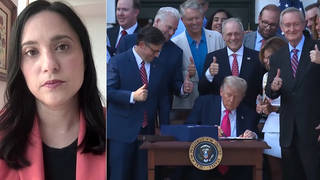
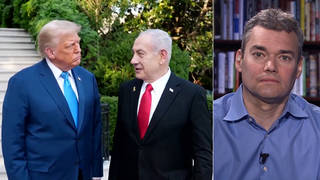

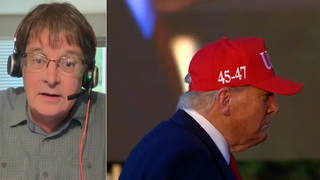
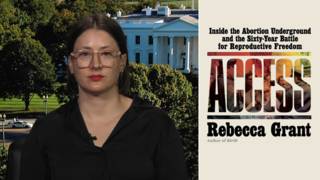
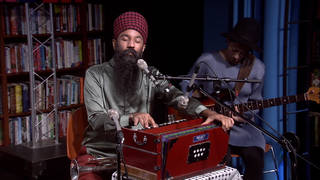
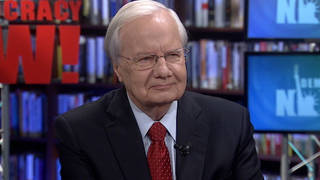
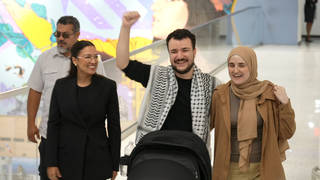

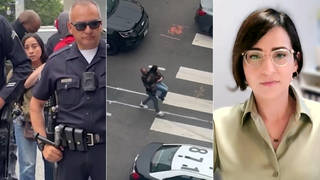

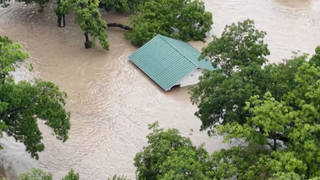
Media Options